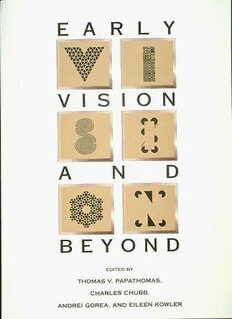
Early vision and beyond PDF
01995·2.155 MB·English
Most books are stored in the elastic cloud where traffic is expensive. For this reason, we have a limit on daily download.
Preview Early vision and beyond
Description:
Using as its springboard Bela Julesz's many seminal contributions in vision, Early Vision presents in one convenient volume strategic problems in binocular vision, visual texture, motion perception, and visual attention. Each is examined from the point of view of at least three major disciplines - psychophysics, computational vision, and neurophysiology.As we gain deeper insights into the workings of the mind, and as technological advances allow bolder experiments, a multidisciplinary approach to the problem of vision is essential. These contributions present progress across disciplines in research on vision processes at the sensory level that are devoid of higher-order cognitive processes and semantics. Although divided into the four major sections mentioned above, chapters and sections are bound by common threads: several chapters report on psychoanatomical techniques, other chapters examine the role of color in diverse areas of early visual processing, while still others share the theme of perceptual learning, a relatively new area of research in early vision.Sections/Contributors :- Binocular Vision and Stereopsis. Christopher Tyler. Randolph Blake. J. J. Kulikowski and V. Walsh. Daphna Weinshall and Jitandra Malik. Gian F. Poggio.- Visual Texture. Roger Watt. Dov Sagi. Terry Caelli. Jack L. Gallant, David C. Van Essen, and H. Christoph Nothdurft. Jonathan D. Victor, Mary M. Conte, and Keith P. Purpura.- Motion. Patrick Cavanagh. Bart Farell. George Sperling and Barbara Anne Dosher. Joseph S. Lappin, Warren D. Craft, and Steven T. Tschantz. Johannes Zanker. Peter H. Schiller.- Attention. Ken Nakayama and Zijiang J. He. Jeremy M. Wolfe, Marvin M. Chun, and Stacia R. Friedman Hill. Merav Ahissar and Shaul Hochstein. John Tsotsos. Robert Desimone, Leonardo Chelazzi, Earl K. Miller, and John Duncan. V. S. Ramachandran.- Afterthoughts. Bela Julesz.
See more
The list of books you might like
Most books are stored in the elastic cloud where traffic is expensive. For this reason, we have a limit on daily download.
